Montessori Pathways' News
September, 2011
Notes from Miss Alena
September is a truly beautiful time in the Chicago area, when the cool breeze sets in and the trees start changing to beautiful color. On the way home one evening, my son asked me “Did you see that tree?” Unfortunately, I had to tell him “No, I did not—I was looking at the road and didn’t notice it. Could you tell me about it?” So he attempted to describe this tree to me: “It was so beautiful. So bright! Orange. I would even say dark salmon.”
Could I have ever imagined that my son would not only be able to notice and observe the beauty of the world, but have in his vocabulary words beyond “green, red, orange,” words as descriptive as “dark salmon?” Now that is real Montessori. If we take a close look at our children, it is possible to see the many differences that have occurred within them since their beginning in the Montessori environment. We would like to invite you to share any interesting moment that have occurred with you and your children—these moments are priceless.
The first month has already flown by and in that short time, our students have become one close-knit family and it is now difficult to distinguish the new students from the returning ones.
Our first school-wide event of the year was the annual Mum’s Sale. We would like to thank the moms who helped unload the truck the morning of the sale—Deanna Hendrey, Katy Jahnke and Karen Sullivan. Also a big thank you to everyone who contributed to the fundraiser itself and helped improve our playground. I hope each of you has heard about the new wooden train on our play ground. The kids love using it as a climbing activity and even try to decorate it with some sidewalk chalk!
A special thank you to Dan Wagler for building and installing this wonderful train!


This year, we will be continuing the Trick-or-Treat for UNICEF tradition that successfully began last year. We will be explaining the importance of this fundraiser to the children in the classroom (how they can be helping kids across the world) and we ask that you give your children a chance to do so—our students absolutely loved knowing that they were helping out last year! We will be sending out more information regarding this wonderful opportunity shortly.
We often receive questions from parents such as “what is my child doing at school? What material is he working with? Why is he working with it? What are the benefits of this material?” Therefore, in each newsletter, you will be able to find detailed information about at least two Montessori materials from different areas that will help answer these questions.
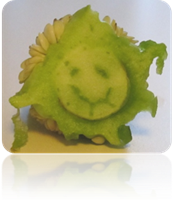
We recently collected the final harvests from our gardens. While cutting one of the green peppers, we were pleasantly surprised to see that this was indeed quite a happy school pepper! He seems to be saying good-bye to the summer and gladly welcoming the fall season as, we hope, you are too.
Warmly,
Miss Alena
Working with Montessori materials:
Hand Washing

Hand washing in a Montessori classroom is more than just getting rid of germs; it is a way to increase a child’s sense of concentration, coordination, order and independence. In the classroom, we have what we call “hand washing stands”. These free standing structures require the child to remember a detailed multi-step procedure that begins with filling a pitcher with water and ends with drying and preparing the stand so it is clean and beautiful for the next person. Without giving you a list of the nearly 20-steps involved in the process, I’d like to explain the reasoning behind and importance of the Montessori hand washing activity.

Nearly every child between the ages of three and six loves to work with water: filling, pouring, feeling, rinsing. It is the quintessential sensorial experience. The hand washing activity builds upon this love of water and focuses a child attention into a meaningful task. The hand washing stand has all of the materials a child needs in order to complete it, however, he/she must remember the order, practice focused concentration and use problem solving. “Can I wash my hands without water? If I fill the pitcher too high what will happen as I carry it? Will my hands be clean if I don’t use the soap? Is the bucket where I pour the dirty water? How will I dry my hands? “
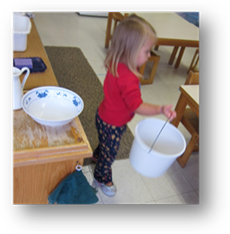
Every child is given a presentation on how to complete hand washing by a teacher. As they practice this many stepped procedure the idea that there is a logical reason behind order and organization becomes apparent to the child. This foundational awareness then transfers into other areas of development. For a child practicing word building they realize, first I must get my moveable alphabet and word building rug, then I can find the letter that makes the first sound in my word. For child completing addition facts they realize, first I must set up my addition board, then get my pencil, then get my paper, then begin my first equation. While it is important to wash hands to get rid of germs and keep everyone healthy, it is truly more than that.
Miss Jocelyn
Working with Montessori materials:
Cutting and gluing
Why is it that children love to cut and why do we love to see them cut … day after day?
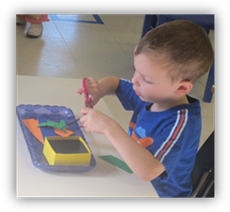
It seems like such a simple, no-brainer task to us. That is because we are so used to cutting that we no longer think about the actual mechanics of it when we use a scissors (end goal!).
But let’s look at the process and challenges of cutting when it is the very young child who is attempting this new task. What are the multitudes of complexities that await the child before mastery?
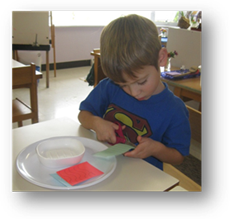
The first thing we notice is that, unlike many other activities, cutting with a scissors requires use of both hands. Not only that, but each hand is doing a totally different activity. The right hand (for right handers) is opening and closing, while the left hand is simply holding the paper (straight in front of them).
One hand is required to be in motion while the other hand is steady and exerting pressure to keep the paper in place. Of course, even before this, they young child has to separate his thumb (to go in one hole of the scissors) and 2 of his four fingers to go in the other hole. No easy task. Many children have a hard time separating fingers and actually use their other hand to help them. And we have all seen the child whose tongue and mouth mirror the movements of the hand. Yes, differentiation of body parts is extremely challenging for the young child.
Then there is the cutting itself. We prepare special strips of poster board for the beginning child. One stroke cutting. It is a simple open and close action. But for the child, a small miracle happens. His actions cause part of the strip to fall off, fluttering down to the desk. Did I really cause that? Let’s try it again. Yep it works. Let’s try it again and again and again and again. That is so satisfying!
Once they have mastered the one stroke cut (or become a little proficient at it), there is the two stroke cut, and then the multiple stroke cut. Then there is the straight cut, the curved cut, the spiral cut. There is cutting different textures: poster board, paper, corrugated paper, etc. They must watch the line they are to cut so they can be accurate.
Mastery takes practice. Think of playing the piano when the left hand is required to do something totally different - play blocks of multiple notes called chords while the right hand plays a complex melody. Then think soft refinement: the left hand must play soft and while the right hand must bring out the melody, often a totally different rhythm. The right hand must be legato while the left hand is percussive.
Think of the potter, the hours they spend in front of the wheel, the smallest pressure on the clay creating a big difference, the slightest movement of the wrist, palms, fingers is exaggerated by the turn of the wheel as the creation assumes form.
We have to practice. We all love the feeling of mastery. Like the pianist or the potter, the child is practicing to master multiple fine movements at the same time. (Oh, we forgot to add that the very young child must also figure out which way is upside down or right side up when holding the scissors!) And so the child will practice and practice and practice, fully engrossed in what he does (watch your paper money that you may have lying around the house). Many even experiment by cutting their (or someone else’s hair). Not that we encourage these experiments, but the child is lost in the world of cutting.
Eventually the skill of cutting becomes automatic. The child needs this skill for another level of activity: making maps, making posters, making complex scenes with art materials, doing collage work, creating 3 dimensional shapes. But, for the moment, the child is just engaged in cutting. He is absorbed. The skill is challenging, but it is a challenge the child somehow knows he can master and strives to do so.
So: hand-eye coordination, use of both hands to do separate skills, the challenge of accuracy, the discovery of effect …all that and more in the simple act of cutting.
Along with learning to cut, the children are learning to glue, a process that is fascinating to them. Wow, I put this stuff on paper, turn it upside down and it doesn’t fall off. Neat!
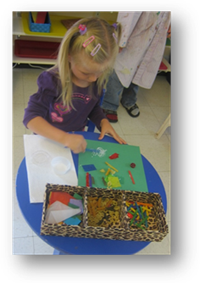
We provide structured but open-ended art activities to help the child to master the use of glue. The child learns sequence:
- assemble your supplies (we have small amounts in individual containers to help control the process)
- set up the needed supplies
- select one item at a time to glue
- turn the item over (Yes, even kindergartners can have a problem remembering this step initially. That is how South America ends up upside down on a map)
- apply the glue
- turn the item over again (place it where you decide on the paper and tap the glued piece down.
- repeat the process as often as you like.
What is the vocabulary that is used when we are talking to the child about his glue activity?
• Overlap
• separate
• empty
• space
• edge
• top
• bottom
• side
• corners
��� next to
• edge
• primary colors
• names of colors
• descriptive words of the collage material used
We encourage you to use this vocabulary also when looking at your child’s creation together (and you will think of even more terms). You will recognize these vocabulary words as mathematical terms that the child needs to learn from experience and repetition.
Also we pre-trace shapes (or later they trace their own shapes) which have their own rich vocabulary: ellipse, oval, quatrefoil, rectangle, trapezoid, pentagon, etc.
So the combination of learning a skill, sequencing a process and adding vocabulary to the mix makes both cutting and gluing a fascinating activity for the young child. On a rainy day, your child would love to just have a box of scraps of different papers, textures, ribbon, etc. for creating his own collage.
When children do not have mastery of the tools (in this case the scissors and glue), the tools themselves actually create frustration by becoming an obstacle in the process of more complex activities.
Miss Karen
Notes from the North Classroom:
Miss Jocelyn and Miss Christine
What a great first month of school! What started out as two groups (new and returning children) has now become one cohesive group of friends working and playing together every day.

In September, we take quite a bit of time to work on what we call Grace and Courtesy lessons in the classroom. These daily presentations build the foundation for the numerous ways in which we instill a sense of peace, order and safety while still maintaining a lively and active work environment. Your child is now able to choose a work, unroll his/her own rug, work with the material either independently or with a friend, put the material back on the shelf and roll up and put away the rug. He/she knows how to ask for help, walk around other people working without disturbing them and be an active and respectful participant of group and line time activities.

This month we have also been extremely diligent in reinforcing good hygiene practices to limit the spreading of germs around our community; proper hand washing technique, how to sneeze and cough into your arm rather than your hands, how to blow your nose and then wash hands, how not to put fingers or hands into the mouth, nose or underneath clothing. As we practice these things daily at school, we are hopeful that we can all stay healthy this school year.
As always, baking and food preparation are a big hit at the beginning of the school year. We were lucky enough to have a huge bounty of apples from the Kindergarten field trip to the apple orchard that enabled us to make a big batch of applesauce as a group. Washing, coring, slicing, mixing, smashing, tasting….the children did it all! As a group, we also shared the story of Johnny Appleseed. The children all loved hearing the story of John Chapman and are now all very interested in the idea that the seeds inside a fruit or vegetable are actually what make the plant grow!
In our wonderful multi-age classroom, this month the children all worked in different areas and with different materials: math, language, science, history, geography, sensorial, practical life and creative work. The beauty of the Montessori environment allows each child to work at his or her own pace while observing other children exploring different hands-on activities all around.
As your child may be cutting or drawing he or she is also probably listening to someone else practice letter sounds and watching another child practice addition facts. Please remember you are always welcome to come in and observe it’s really the best way to know what your child is really doing at school!

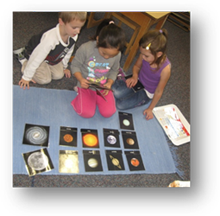
Miss Jocelyn and Miss Christine
Notes from the South Classroom:
Miss Karen and Miss Ambreen

This month was certainly filled with celebrations in our room. It began of course, with the excitement of being back in school (That seems like a long time ago!). But it continued throughout the month as we also celebrated six birthdays! Yes six. Thank you to the families for filling out the individual birthday sheet we sent home as this allows us to make each birthday celebration personalized and special.
There is getting to be that “settled” feeling in the classroom. In addition to the regular Montessori curriculum activities, we have gotten into the groove of weekly music, Spanish and PMD.
Also “thank you to the gardening mom” who has taken the children out in pairs to weed, dead-head the plants and trim them up. This experience however, is about more than maintaining plants. Many of us have learned our love of gardening when we were children helping our mothers in the garden. The gardening moms talk about WHAT we are doing and WHY we are doing it.
We take out the weeds because weeds take food and water and sunlight that the flowers need to thrive. And we need to get the weeds out by the roots or they will grow right back up. But then we can look at the roots and really see them in detail. In addition, many miniature science lessons take place: worms are fascinating, bugs interesting, and soil is wet after a rain.
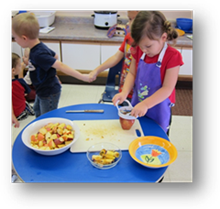
One of the events of the month was making applesauce. The process took several days. Some of the children washed the apples, others cored and cut the apples, some helped to put the apples through the food mill until, at last, we had applesauce. Delicious. The smell of cinnamon and cooking apples is an autumn smell. The children love the process and we invite you to please send in extra apples you may have now when they are plentiful. The ones we used came from the Kindergarten field trip, but more are always welcome.
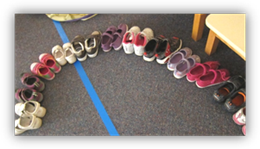
We often talk about a sense of order. Don’t you frequently see your child lining up their toys, stuffed animals, etc. Children love to see things in their place. Well, we had a special sense of order as one of the three year olds lined up all the nap shoes in a half circle. “See, I made a rainbow of shoes!!” To be a three year old again and see a rainbow in shoes!
Often when we are observing, it is the small things in the class that are so interesting. One day, a three year old was trying to use a small spray water bottle. No matter how hard he tried, the water would always squirt him in the face. He would look startled, knowing that he really wanted to clean the mirror, not wash his face, so he would try again. Over and over he would repeat the action: spray the bottle, look startled, and wipe off his face. THEN, what joy when he made a small adjustment and turned the bottle. “Yes. I can figure this problem out myself all by myself” he must have thought as he was beaming.
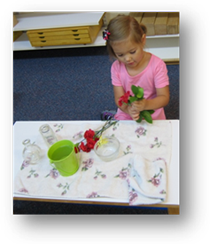
Thank you to the many families for bringing in items we share with the class for snack (and also for the delicious birthday treats). The children enjoy having something to bring and help to prepare it for the classroom. The lovely bouquets of flowers were cut by the children and arranged in small individual vases.
The vases were set on the individual tables the children sit at while working. It was lovely to see them spread around the room.
Thank you to Colleen Nieckula, one of our sewing moms, for helping with the placemats.
Also to Malcolm’s mom for bring in the pepper plant to share with the classroom. It came with a beautiful, large, ripe pepper too. How nice for the children to see the mature vegetable still on the plant.
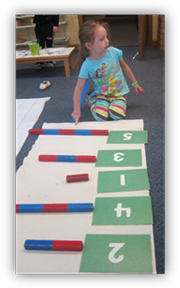
We would love to have a library mom who would pick up and return specific books for us. We will be starting our “Author of the Month” reading in October and could use a little help.
Also we could use another mom (or dad or grandparent) to help with sewing---nothing fancy. Usually just hemming or very simple repairs.
If you would like to be a “garden mom” in the morning, let us know. You can pretty much choose any hours that suit your schedule. We still have some warm days left. We would appreciate a donation of a few bulbs you may have left over. The children could plant them and then, almost magically, see them come up in the warm spring.
It’s been a wonderful month and we are off to such a good start. The children who are new to the room are so much more comfortable. It is a pleasure to work with your children.
Miss Karen and Miss Ambreen
Kindergarten Extended Day

We have a great group of Kindergarteners this year! The beginning of the Kindergarten year is a very exciting time. There are new expectations, new responsibilities, new experiences and a lot of new work!
As the Montessori philosophy allows for freedom of choice within a structured environment, the Kindergartners are learning how to navigate their individual work plans, act as role models, help others, try new things and explore the world around them. One of the great features of Kindergarten at Montessori Pathways is the commitment to real world experiences in the form of meaningful field trips that extend what is being learned in school.
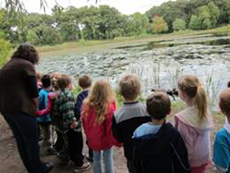
In September, the Kindergarteners traveled to the All Seasons Apple Orchard, the Prairie view Nature Center and went on a walking field trip to Veteran’s Acres on the first day of fall.
The first field trip of the year gave the children the opportunity to go apple picking at a local orchard. After weeks of studying about the parts of the apple and the life cycle of the apple, learning to identify different varieties of apples and participating in apple tasting experiments, the children then went out as a group and experienced where apples grow, who takes care of them and how to pick them properly from the tree so as not to pull off the bud for the following year.

Upon returning to school the children took some of their apples home to share with their families and left the remainder at school to share with their friends. A question was then posed to the children, “How will we divide all these apples up at school?” It became a real-life division problem. Three bins for the three classrooms were produced and the children took turns sorting the apples. As fate would have it, the apples did not divide out evenly and the next question arose, “what should we do with the one extra apple, what would be fair?” After just a short period of time, one child excitedly exclaimed we should just cut it into thirds. Now that is a real and meaningful understanding of fractions!
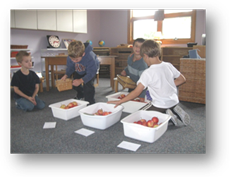
In addition to field trips, the Kindergarteners have been working hard every day. Advanced math works, learning sounds, sight words and reading, making maps, practicing proper letter and number formation, participating in science experiments, beginning journal writing and much, much more. Additionally, the Kindergarteners have already had some experience working on multi-day projects.
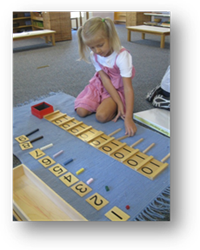
The idea that work can and will take more than one day to complete is essential at this age as it requires organization, planning, perseverance and concentration. In a society that often thrives on immediate gratification, a project approach gives a child the opportunity to explore and discover in a slow paced and meaningful way.
The Kindergarteners’ first project was a self-portrait with Ms. Teri. On the first day, she focused the children’s attention of their own facial features by providing small mirrors for every child to look into as they sketched. She asked questions like “What shape is your face? Touch your nose and then move your fingers back toward your ears, look in the mirror where are they on your face? Put your hands on the bottom of your ears and move toward your mouth, is it even?” This approach was eye opening (literally) for many of the children as they set out to draw their own face. On day two of this project, Ms. Teri focused on coloring specific facial features (eyes, hair and lips), as every person is different and so is their coloring.

Another multi-day project the Kindergarteners completed was making color wheels. We spent a week exploring the subject of primary and secondary colors. As we were watching the leaves change colors outside every day, naturally we began to discuss colors in the classroom. The children were given the opportunity to work with several activities to explore color mixing and discovered which colors where primary and why, as well as which colors when mixed together create other colors (secondary colors).
Miss Jocelyn
Notes from the afternoon classroom:
Miss Terri

The afternoon class has been a very busy place this month. One of our main jobs after outdoor play is to help maintain the outdoor environment. The children help return any toys, vehicles, balls, brooms, ets. To their proper places before we come back inside. We also pick up sticks, water flowers, pick up and return rubber mulch as needed. Once we are back inside we change shoes, use the bathroom, wash our face and hands, hang up our coats and straighten the shoes in the closet. We have a “rubber chip” bucket handy for the children to pick up any rubber mulch pieces we find in the hallways or classroom. Believe it or not your children love the job! They love to keep our room and school beautiful.
The afternoon schedule includes work time, story time, quiet/rest time, snack preparation and art activities.

Snack preparation is quite a big job since we make snack for all the kindergarteners and nappers who are there after 3:15. We count out the dishes (hands washed first!), cut/prepare and count out snack for each dish. We try to bake at least once a week and that becomes our snack for the day with fruit (grapes, pears, oranges, apple slices, etc.).
Once snack that we made was carrot cake and it was delicious! The children grated 4 cups of carrots (lot of strong muscles needed). We used 8 eggs since we doubled the recipe – boy was that fun. Four children got to crack 2 eggs each. So much is involved in baking and it uses all the senses. We learned cinnamon smells so good but it doesn’t taste too good without sugar. Also, a favorite part of baking is getting to taste the batter – which everyone gets to try. The bakers, however, get to lick the beaters!
On our art projects this month was a bumblebee picture. This work took several days and used many different small motor skills. We first practiced, and then drew circles and ovals for the bee’s body. We outlined this with a black marker adding stripes, wings, legs and antennae. We colored the bees and grass with craypas then drew, colored, cut out and “feathered” the clover flowers with scissors.
As the children are shown how to care for their classroom and their environment, they are also learning to become good workers. Every day they have opportunities to learn to share, work together and cooperate. This week (when it was sunny!) we learned to play “Hide and Seek” and “Follow the Leader.” The children took turns and made new friends as they chased and hid and yelled, “Ready or not, here I come!” They also had a lot of fun!
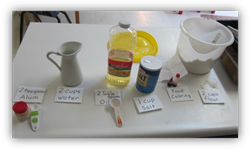
Here is the Carrot Cake recipe for those of you who asked. Enjoy!
Carrot Cake
2 c. flour
1 t. baking powder
1 t. baking soda
1 t. cinnamon
¼ t. salt
Combine:
1 ½ c. salad oil
2 c. sugar
Mix well and then add 4 eggs, one at a time. Beat after each addition. Gradually add dry ingredients. Mix well. Add 2 cups finely grated carrots. Mix. Pour into greased pan. Bake at 350 for 50-60 minutes.
Miss Katy

September has flown by. The afternoon "nappers" have gotten to know each other better over the past month. It is a joy to watch the children become more comfortable in school and with one another. We have continued our routine of waking up and putting away cots to get ready for our snack. We have also continued to have story time and musical activities following snack. Some children have begun making requests for books about certain subjects including books about watermelons and stories about princesses.
During my weekly trip to the library I have attempted to meet their requests. A favorite book of the children this month was Monkey: A Trickster Tale from India by Gerald McDermott.
We have continued to focus on the importance of ourselves. The children completed a poster of their name which included handprints and footprints. We also used salt dough to role the first letter of each child's name, and finished it off by painting one of the three primary colors. Both of these projects required the students to use their fine motor skills to add the fine details along with their own creativity. We finished out the month by making self portraits. To discover our eye color, each child was able to look in the mirror. The children also used different colors of yarn to find their hair color.
I am looking forward to October. We will begin to focus our attention on family and fall.

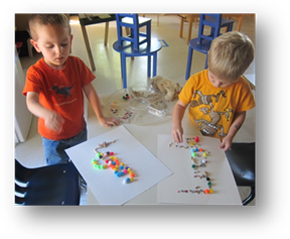
Miss Terri and Miss Katy
Gym Class with Ms. Donna
We are almost finished learning our driving warm up cues. Ask your child to show you what we do when I say:"It's raining" or "school zone".
We are learning how to control balls: toss and catch, bounce and catch, toss, clap, catch, bounce to a partner, do over head throwing, roll ball through a tunnel. Played a game called over and under the first time the ball goes over your head where the person behind you takes it from your hands when it gets to the last person he/she brings it to the front of the line and the ball continues go over heads until everyone has had a chance to be first. We then we put the ball between our legs and continued until all had a turn to be first.
We learned a game called "Traffic Lights" a Green paper meant that you could go, a Yellow paper meant walk in place, and a Red paper meant stop completely.
We also used bean bags, toss and catch, put them on different body parts and walk while keeping the bean bag on you. We used the bean bags to practice underhand throwing while throwing through a noodle hoop.
We found that we could toss a scarf into the air and catch it with the same hand, toss our scarf into the air and catch the scarf with our other hand, and use two scarves one to toss the other to place in the hand that was now empty and catch the first scarf in the other empty hand.
Kinders also learned two games one being Elbow Tag and the other Hoop Jumper. We began Hoop Jumper by practicing jumping into a hoop on the ground. We learned how to jump in using 2 feet and jump out using 2 feet, use 2 feet in and 1 foot out, and 1 foot in and the opposite foot out. Boundaries were set; we had one tagger who had to use a ball to touch a child. When you were caught you stood still and raised your hand then a hoop un-freezer would come to you. Depending on the color of the hoop you would do one of our practice jumps to un- freeze yourself. Every so often we would change the tagger and the hoop un-freezers.
Elbow Tag began with partners connected by elbows two students were not connected. One was the police officer and the other the robber. The police officer would try to catch the robber. If either of them got tired they could hoop up with one side of the partners. The partner they hooked up with would stay and the other partner became the robber or the police officer.
Miss Donna

Gym Class with Ms. Donna
March had us continuing our loco-motor skills, as well as throwing and catching a ball with a partner. We also began leaping or jumping over folded mates and jumping over the long jump rope as it was wiggling on the floor.
Stations were introduced this month. Children were assigned a station for a certain amount of time. When time was called they had to make sure that their station was set up for the next group before they could move on.
The stations were ski jump (you jumped over a jump rope on the ground keeping your feet together), throwing bean bags underhand and overhand into a small ring inside of a hula hoop, scooter trail (following a path while sitting on the scooter just using your legs and then following the path laying on the scooter using your arms and legs, and our last station was crawling through tunnels.
Miss Terri and Miss Donna
